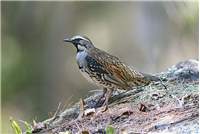Family
Orthonychidae
Genus
Cinclosoma
Species
punctatum
Threats/Control Methods - Regional
This species is heavily dependant on the surrounding woodland and forest areas of the ACT. This forest area is considered an Endangered Ecological Community and is threatened by the expansion of rural residential developments, clearing for grazing and agriculture, firewood collection and weed infestations.
Threats/Control Methods - Local
This species has disappeared from the suburbs, probably due to habitat fragmentation and lack of forested areas that are safe from predation by wandering domestic Dogs (Canis familiaris).
Local/Urban Actions
The few remaining birds that may exist in local reserves would be safer if dog owners always keep their pets on a leash and cat owners create a stimulating indoor environment and install a cat run or enclosure. Collecting firewood from nature reserves or national parks should not be undertaken, as this will impact on the important foraging and nesting resources. Joining with local conservation groups to participate in tree planting or bush regeneration activities like Landcare or Greening Australia will help improve the threatened habitat of the Spotted Quail-thrush.
Common Names
Spotted Quail-thrush, Spotted Babbling-thrush, Spotted Ground-bird
Distinguishing Features
This medium-sized bird of 26-28cm has a very patterned appearance, which acts as effective camouflage on the forest floor. Male birds have a black throat with a white patch under their blue eye and a white eyebrow. A thick band of blue-grey feathers spread from the eye and across the breast. The top of the head, back, wings and tail are brown to grey, with black and white markings throughout. Underparts are white with dark spots. Females and young birds are sightly lighter and have a pale orange colour on the throat instead of the black.
Survey Techniques
Call and visual identification.
Species Call
A loud double whistle 'whee-it', a 'wheet-wheet-wheet' sequence, or high twittering.
Similar Species
This species is unique-looking across its range.
Distribution
The Spotted Quail-thrush is found across eastern Australia from southern QLD to western VIC, with subspecies in the Mt. Lofty Ranges of SA and in the east of TAS.
Country of Origin
Australia
Conservation (Pet/Pest) Status - Regional
In 1993 it was considered uncommon to see this bird, however now it is so rare that recent bird surveys do not include this species at all.
Conservation (Pet/Pest) Status - National
Secure, not listed under the EPBC Act 1999. However, it is considered to be declining across its range. The population of the Mt. Lofty Ranges (Cinclosoma punctatum anachoreta) is Critically Endangered, as it is a tiny, isolated and declining population.
LSCCES Population
Three sightings were made at the northern, less developed area of the ANBG.
Associated vegetation community
This species inhabits eucalypt forest and woodland, especially in areas with rocky ridges and short spiky grass clumps.
Limiting Resources
This species needs large forest areas with little interference from land clearing and the removal of ground cover and fallen logs, or the invasion of weeds.
Breeding
Most breeding takes place from August to December and in a good season birds can produce up to 3 broods. The nest is built on the ground; sheltered by a nearby fallen log, tree stump or rock. It is an open cup shape, made loosely of grass, leaves and bark. The 2-3 eggs are creamy and covered with small, colourful spots.
Behaviour
This species can be seen alone or in pairs, crouching low to the ground. It is extremely shy and relies on its camouflage before flying away in a sudden burst of feathers with a 'whirr' call if approached. Males perch on low tree branches to call.
Functional Group
Food Species
The Spotted-Quail-thrush will eat insects, seeds and some very small reptiles.
Predators
This shy ground-dwelling species is likely to be attacked in the forest by European Red Foxes (Vulpes vulpes) or Dogs (Canis familiaris).
Interesting Fact
The camouflage of the Spotted Quail-thrush is excellent, and when the incubating adult sits on the nest, it can hardly be seen on the forest floor.
References - (reader suitability of references, P=Primary teachers, S=Secondary students, T=Tertiary students and researchers)
Books:Morcombe, M. 2000. Field Guide to Australian Birds. Steve Parish Publishing. Archerfield. Australia P, S, T
Schodde, R. and Tideman, S. (eds) 1990. Reader's Digest Complete Book of Australian Birds (2nd Edition). Reader's Digest Services Pty Ltd. Sydney. P, S, T
Simpson, K. and Day, N. 1993. Field Guide to the Birds of Australia. Penguin Books Australia Ltd. Ringwood VIC.
Online Publications:Environment ACT. 2006. Yellow Box/Red Gum Grassy Woodland (An Endangered Ecological Community). ACTION PLAN No.10. [online]. Available at:http://www.environment.act.gov.au/__data/assets/pdf_file/13428/actionplans10.pdf S, T
Garnett, S. and Crowley, M. 2000. The Action Plan for Australian Birds 2000. Department of Environment and Water Resources. [online]. Available at: http://www.deh.gov.au/biodiversity/threatened/publications/action/birds2000/index.html S, T
Nix, H. and Cunningham, R. 2006. Birds of the Lower Sullivans Creek Catchment, Canberra ACT. Prepared for the Life in the Suburbs project using data from the Lower Sullivans Creek Catchment Ecological Survey (LSCCES). Australian National University. Canberra. [online]. Available at: http://www.lifeinthesuburbs.com.au/category.php?id=65 S, T

 Top
Top Top
Top